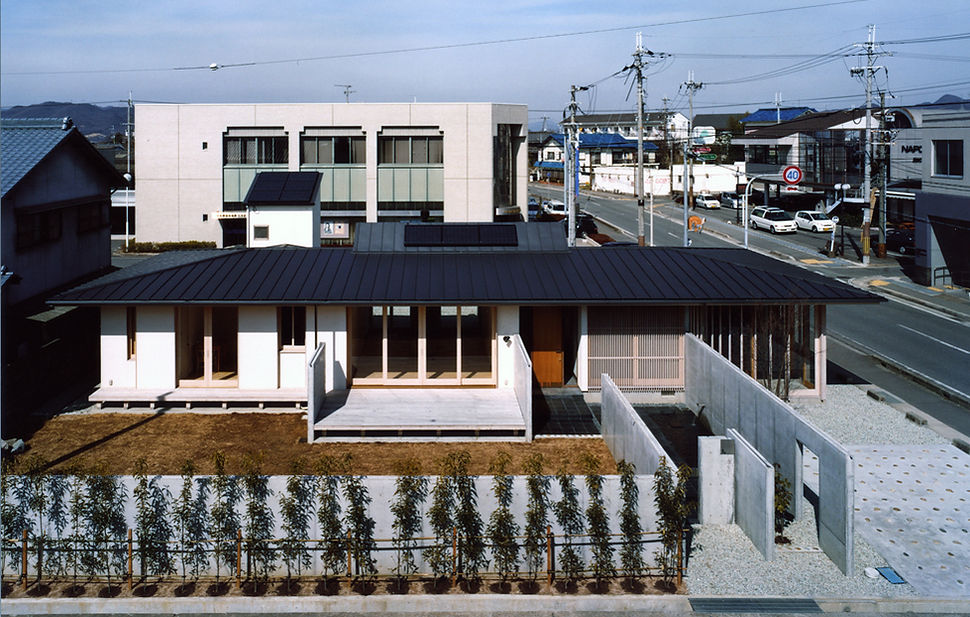house in Wakagaya Photos of 11 years after completion

[Photo at the time of completion (photographed by Junichi Tamamori)]
There is a concrete wall from the edge of the site through the building. The housing part and the atelier (work space) are divided symbolically.

Photo 11 years later

Because the eaves are deep and the slope of the roof is loose, the thin roof looks light.

Photo 11 years later

The trees in the garden also grow and become a calm outside space.

Connecting the living room to the south garden with a deep eave and deck.

There is steady light falling from the north-facing top side light at the entrance.

From the living room to the south garden. There is a slit of the horizontal grid in the ceiling. Diffuse and capture light from the top.

Photo 11 years later

Garden trees and garden stones

On the north side of the living room, the floor is lowered by one level. The garden in the north and the garden in the south are different.

Fence using steel pipe for construction that is no longer used ... adhesion of rust and concrete is kept as it is. I dare to leave traces of the material.

Japanese-style room · · · The concrete wall that is continuous from the outside is used as it is to finish the inner wall.

Bedroom: Lighting fixtures are embedded in the wall niche.

Kitchen ... The kitchen is designed using stainless steel.

The bathroom ・ ・ ・ The partition is transparent glass and makes space feel spacious.
There is also a small garden in the bathroom, and it is an external space with privacy protected inside.

In the atelier (work space), you can see the continuous concrete wall from the outside.

Photo 11 years later

Entrance: The floor is made of stone. It continues to the outside and makes it feel the spread of space.

There is a basin along the approach to the entrance.
The water is from the well on the site.

Facade night view
House in Wakagaya was completed in 2003, and in the 11th year in 2014, I took photos again. I wanted to record how beautifully the building continues to change over 10 years.
location
It is located in the central area of the town and was originally used as a lumberyard for lumber mills. Two of the four sides of the site are roads, and one is a waterway, so the immediate neighbor is only the west side. Each is a bank, post office, house, apartment complex, and is surrounded by low rise buildings of 2 to 3 floors.
concept
It is a home for two couples and has an atelier of work.
Since this site was originally opened, the intersection corner of the road is an open space to ensure the previous perspective. The area on the south side is set open from the border line of the site, for example, by setting back from the site boundary and setting it as a hedge of white oak.
The area around the site is rich in people to banks and post offices, and the environment is relatively busy during the daytime. It was examined how to maintain the privacy as a house and expand the publicity of the atelier.
The building has RC walls extending to the north-south border of the site. It divides into the zone of the atelier and the zone of the residence bordering on this wall, and keeps each space. The external space is further divided by several RC walls and set as a part of a continuous space from the inside.
I imagined the shape that the thin roof of a single house covered the space divided into several. The thin roof widens the north-south surface, narrows the east-west surface, and has a weir depth of 1.1m. Avoid the summer direct, drop the shade of the room indoors. It was planned to make use of the characteristics of Japanese culture.
In addition, energy saving, resource saving and load reduction are realized in terms of equipment.
The specific measures are as follows.
* Passive system: used a large roof area. Air heated by solar heat is dissipated to the inside in winter and exhausted to the outside in summer.
* Solar power system: Supply electricity generated by solar panels to the building.
* Well water use: From the well on the site, use for toilet bowl washing water, water sprinkling and washing water.
The materials used are as much as possible of solid materials such as wood, stone, diatomaceous earth and similar materials. As time went on, I thought of a house that enjoyed gradual changes in materials.
data
· Location: Kato City, Hyogo Prefecture
· Use: housing
· Design, supervision period: April 2002-July 2003
· Scale, structure:
① Total area: 138.99m 2
② Wooden 1stories


